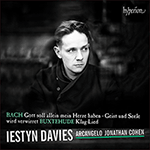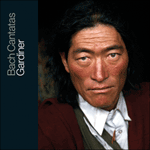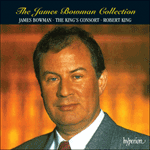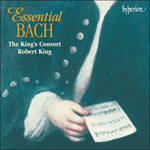
Welcome to Hyperion Records, a British classical label devoted to presenting high-quality recordings of music of all styles and from all periods from the twelfth century to the twenty-first.
Hyperion offers both CDs, and downloads in a number of formats. The site is also available in several languages.
Please use the dropdown buttons to set your preferred options, or use the checkbox to accept the defaults.

Bach himself may have had a hand in the cantata’s libretto, which develops the themes of loving God and one’s neighbour from the Gospel readings for the day—1 Corinthians 1: 4-8, in which St Paul gives thanks for the virtue of the Corinthians, and Matthew 22: 34-36, where Christ answers the Pharisees’ taunting question, ‘Master, which is the great commandment in the law?’ After the sinfonia-cum-organ-concerto, a brief arioso in minuet rhythm presents the cantata’s ‘motto’, ‘God alone shall have my heart’. This then alternates with recitative to create the effect of a dialogue, with characteristic touches of word-painting like the continuo’s little flourish of semiquavers to evoke the gushing brook.
The first aria takes up and elaborates the motto far more confidently, its sturdy vocal line adorned by a florid organ obbligato: another movement that fuses the sacred with the secular. In the following recitative Bach the word-painter contrasts the falling chromatic line of ‘Sie schließt die Hölle zu’ (‘It shuts hell’s gate’) with the triumphant ascent of Elijah’s chariot.
Bach evidently felt that the bittersweet siciliano from the (lost) concerto, with its richly textured string accompaniment, was particularly apt for the second aria, on the familiar Pietist theme of withdrawal from the world. Note especially the contorted setting of ‘verworf’nen Fleischestriebe’ (‘depraved carnal impulses’—Lutheran moralizing in full cry!), and the wearily sinking chromaticism to intensify the singer’s final ‘Stirb in mir’ (‘Die in me’). After a brief recitative, the cantata ends with a plain four-part harmonization of a pre-Reformation chorale melody.
from notes by Richard Wigmore © 2022
Il est possible que Bach lui-même ait participé au livret de cette cantate, qui développe les thèmes de l’amour porté à Dieu et à son prochain dans l’Évangile du jour—1 Corinthiens 1: 4-8, où saint Paul rend grâce pour la vertu des Corinthiens, et Matthieu 22: 34-36, où le Christ répond à la question provocante des Pharisiens, «Maître, quel est, dans la loi, le commandement le plus grand?». Après le concerto sinfonia avec orgue, un bref arioso sur un rythme de menuet présente le «motto» de la cantate, «Dieu seul doit posséder mon cœur», qui alterne ensuite avec le récitatif pour créer un effet de dialogue, avec des touches caractéristiques d’illustration du texte comme les petites fioritures en doubles croches du continuo pour évoquer le ruisseau jaillissant.
La première aria reprend et élabore le motto avec beaucoup plus d’assurance, sa ligne vocale énergique étant ornée d’un obbligato très chargé à l’orgue: un autre mouvement qui réunit le sacré et le profane. Dans le récitatif suivant, Bach, l’illustrateur de texte, fait ressortir le contraste entre la ligne chromatique descendante de «Sie schließt die Hölle zu» («Il ferme la porte de l’enfer») et l’ascension triomphale du char d’Élie.
Bach trouva manifestement que la sicilienne douce-amère du concerto (perdu), avec son accompagnement de cordes à la riche texture, se prêtait tout particulièrement à la seconde aria, sur le thème piétiste bien connu du retrait du monde. Notez en particulier la manière contorsionnée avec laquelle il met en musique «verworf’nen Fleischestriebe» («instincts dépravés de la chair»—leçon de morale luthérienne à pleine voix!), et le chromatisme qui sombre péniblement pour intensifier le «Stirb in mir» («Mourez en moi») final du chanteur. Après un court récitatif, la cantate s’achève avec une harmonisation simple à quatre voix d’une mélodie de choral antérieure à la Réforme.
extrait des notes rédigées par Richard Wigmore © 2022
Français: Marie-Stella Pâris
Möglicherweise war Bach selbst an der Anfertigung des Librettos beteiligt, das sich mit den Themen der Gottes- und Nächstenliebe aus den Lesungen des Evangeliums für jenen Tag befasst—1 Kor 1, 4-8, in dem Paulus für die Tugend der Korinther dankt, und Mt 22, 34-36, wo Christus die spöttische Frage der Pharisäer beantwortet: „Meister, welches ist das größte Gebot im Gesetz?“ Nach der Sinfonia (sozusagen ein Orgelkonzert) stellt ein kurzes Arioso im Menuett-Rhythmus das „Motto“ der Kantate vor: „Gott soll allein mein Herze haben.“ Dies alterniert dann mit dem Rezitativ, um einen Dialog anzudeuten, und dazu finden sich charakteristische Anklänge von Wortmalerei, wie etwa die kleine Sechzehntelfigur im Continuo, mit der der rauschende Bach dargestellt wird.
Die erste Arie nimmt das Motto weitaus selbstbewusster auf und verziert es; die kräftige Gesangslinie wird von der obligaten Orgelstimme geschmückt: auch hier verschmilzt das Sakrale mit dem Weltlichen. In dem sich anschließenden Rezitativ stellt der Wortmaler Bach die fallende chromatische Linie bei „Sie schließt die Hölle zu“ dem triumphierenden Aufstieg von Elias’ Wagen gegenüber.
Bach empfand offensichtlich das bittersüße Siciliano aus dem (verschollenen) Konzert mit seiner vielschichtigen Streicherbegleitung als besonders passend für die zweite Arie über das bekannte pietistische Thema des Abschieds von der Welt. Man beachte besonders die verzerrte Vertonung der „verworf’nen Fleischestriebe“ (lutherisches Moralisieren par excellence!) und die müde hinabsinkende Chromatik zur Intensivierung des abschließenden „Stirb in mir“ der Singstimme. Nach einem kurzen Rezitativ endet die Kantate mit einer schlichten vierstimmigen Harmonisierung einer vorreformatorischen Choralmelodie.
aus dem Begleittext von Richard Wigmore © 2022
Deutsch: Viola Scheffel
 Bach: Cantatas Nos 35 & 169 Bach: Cantatas Nos 35 & 169Both of these cantatas may have been written for an outstandingly gifted boy alto in Bach’s Leipzig, but—listening to these peerless accounts—it’s impossible to believe he could have approached Iestyn Davies’s flawless technique and profound inter ...» More |
 Bach: Cantatas Nos 47, 96, 114, 116, 148 & 169 Bach: Cantatas Nos 47, 96, 114, 116, 148 & 169Volume 9 in the series (the seventeenth and eighteenth Sundays after Trinity) presents a powerful programme recorded in Bach's resting place, the iconic Thomaskirche in Leipzig. The soloists include Nathalie Stutzmann, Mark Padmore, Christoph Gen ...» More |
 The James Bowman Collection The James Bowman Collection'The James Bowman Collection' deserves the strongest and warmest of recommendations … This is glorious music-making and deserves the widest possible hearing' (The Daily Telegraph) 'La intensa expresividad, la técnica y el color de la voz d ... » More |
 Essential Bach Essential Bach'This is a good introduction to Bach and a useful disc for those who want to sample his varied music' (Contemporary Review)» More |

